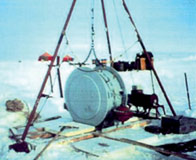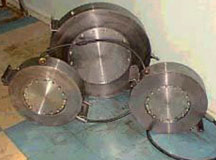The development and production of high-power emitters for research in the field of LF hydroacoustics from the beginning of the 1980s and until now remains one of the main IAP RAS activities (headed by B. N. Bogolyubov). During this time the LF emitters and the emitting complexes based on them have been used in numerous field experiments in the water areas of all the four oceans. These experiments have demonstrated the possibility of LF sources to efficiently excite sound fields at distances of hundreds and even thousands of kilometers, the intensity of which is sufficient for solving a number of fundamental and applied problems of ocean acoustics, primarily, the problems of remote sensing and underwater environment illumination.
Sonar transducers of different types were developed in different years at the IAP RAS. Initially, priority was given to the creation of narrow-band electromagnetic and broad-band electrodynamic sources. In recent years, the emphasis has shifted to the creation of a new type of piezoelectric emitters.
Narrow-band emitters of the electromagnetic type are designed for the generation of high-intensity hydroacoustic signals and for the development of systems for the acoustic illumination of underwater environment in large water areas. In 1970—1990s, much prominence was given to them and, as a result, a series of such emitters for various frequency ranges was created. They are characterized by a high specific radiation power (up to 40 W/kg), a high reliability (life time is 108 —1010 fluctuation cycles), a high
efficiency (80%), and a relatively low cost. Some of them have been successfully used to design multi-element antenna systems with controlled amplitude and phase distributions, enabling one to provide the required spatial distribution of the acoustic field in an underwater sound channel (B. N. Bogolyubov,
A. G. Luchinin, M. M. Slavinsky, and V. I. Talanov).
Broad-band hydroacoustic emitters of the electrodynamic type are designed for the operation in towed complexes and arrays employed for hydro-acoustic sounding in water areas in the 15 Hz— 1.5 kHz frequency band (the radiation level is
200 Pa/m). The magnetic system of the emitters is made using permanent magnets of rare earth metals with a high coercive force. The new technology permitted developing the small-size broad-band radiators capable of emitting coherent acoustic signals with various types of frequency and phase modulation.
A new generation of piezoceramic transducers for ocean acoustics is actively developed in the recent decade. They are the main focus at the moment. Significant progress in designing such sound sources is achieved due to an extensive use of finite-element modeling.
 |
 |
LF emitter for the Arctic studies
(the signal-carrying frequency is 20 Hz) and electromagnetic-type emitters (for the frequencies from 70 to 600 Hz)
|
Important advantages of the piezoelectric emitters compared with the emitters of electromagnetic and electrodynamic types are low price of their manufacture and easy exploitation. When operating in a large range of depths (down to several hundreds meers), piezoceramic transducers do not require compensation for the hydrostatic pressure.
 |
|
Piezoceramic emitters
of the longitudinal-bending type
|
|
At the IAP RAS, considerable attention is paid to the design and production of piezoceramic radiators of the longitudinal-bending type. Numerous models of such radiators with resonant frequencies of a few hundred hertz, which provide a radiation level of
206—210 dB with typical values of the radiation frequency band of more than 30% of the carrier frequency, and an efficiency of 60—90%, were designed, manufactured, and tested in numerous experiments under field conditions.
Piezoceramic emitters of the longitudinal-bending type prove to be promising for the solution of some applied problems in hydroacoustics. Their basic advantage is small size in combination with a high specific radiation power. Such emitters were designed and tested in operation at a carrier frequency of order 1 kHz, a radiation level of about 190 dB, with an efficiency of 50—60%, and in a bandwidth of about
20% of the carrier frequency.
Low-frequency hydroacoustic radiating antennas were originally based on narrow-band electromagnetic sources. They were designed both to increase the total radiated power of signal and to control the spatial distribution of the sound field in an ocean waveguide. They were used in field experiments on LF acoustic sounding of the ocean, which yielded important results concerning the creation of systems for illumination of an underwater environment in large water areas.
In recent years, research work in this field is based on the use of high-power and relatively broad-band piezoceramic sources. The sources of this type are the elements of the linear radiating antenna newly created at the IAP RAS. Further development of the emitting complexes is associated with the designing and manufacturing of vertical multi-element antenna arrays with controlled amplitude distribution. Piezoceramic transducers of the longitudinal-bending type are considered as elements of this antenna. Theoretical estimates and field experiments indicate that the LF radiating complexes developed on their basis can be used to solve a broad class of applied problems involving the illumination of an underwater environment in the vast water areas under hydrological conditions typical of deep and shallow seas.
|
|
Model of piezoceramic emitter
of the longitudinal-bending type
|
Three-dimensional six-element radiating antenna
|





